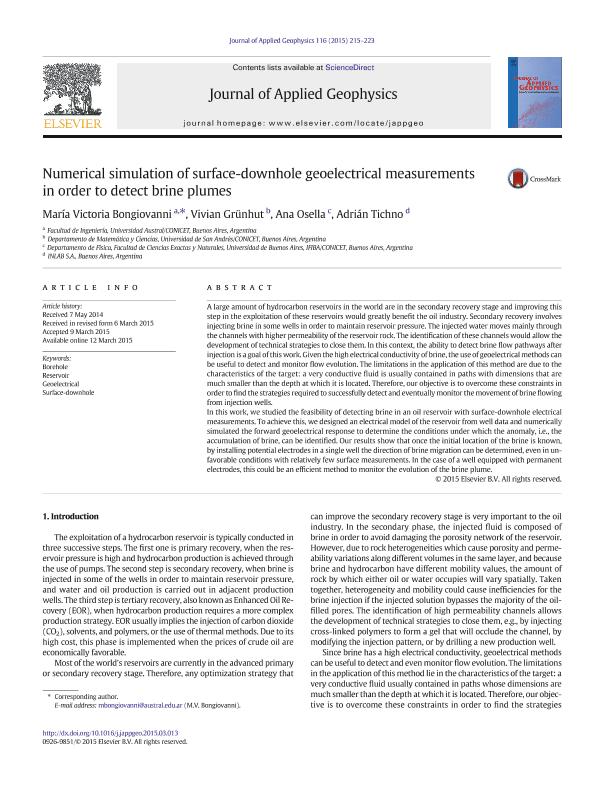Mostrar el registro sencillo del ítem
dc.contributor.author
Bongiovanni, Maria Victoria Flavia

dc.contributor.author
Grünhut Duenyas, Vivian

dc.contributor.author
Osella, Ana Maria

dc.contributor.author
Tichno, Adrián
dc.date.available
2018-03-08T19:46:02Z
dc.date.issued
2015-05
dc.identifier.citation
Bongiovanni, Maria Victoria Flavia; Grünhut Duenyas, Vivian; Osella, Ana Maria; Tichno, Adrián; Numerical simulation of surface-downhole geoelectrical measurements in order to detect brine plumes; Elsevier Science; Journal Of Applied Geophysics; 116; 5-2015; 215-223
dc.identifier.issn
0926-9851
dc.identifier.uri
http://hdl.handle.net/11336/38306
dc.description.abstract
A large amount of hydrocarbon reservoirs in the world are in the secondary recovery stage and improving this step in the exploitation of these reservoirs would greatly benefit the oil industry. Secondary recovery involves injecting brine in some wells in order to maintain reservoir pressure. The injected water moves mainly through the channels with higher permeability of the reservoir rock. The identification of these channels would allow the development of technical strategies to close them. In this context, the ability to detect brine flow pathways after injection is a goal of this work. Given the high electrical conductivity of brine, the use of geoelectrical methods can be useful to detect and monitor flow evolution. The limitations in the application of this method are due to the characteristics of the target: a very conductive fluid is usually contained in paths with dimensions that are much smaller than the depth at which it is located. Therefore, our objective is to overcome these constraints in order to find the strategies required to successfully detect and eventually monitor the movement of brine flowing from injection wells. In this work, we studied the feasibility of detecting brine in an oil reservoir with surface-downhole electrical measurements. To achieve this, we designed an electrical model of the reservoir from well data and numerically simulated the forward geoelectrical response to determine the conditions under which the anomaly, i.e., the accumulation of brine, can be identified. Our results show that once the initial location of the brine is known, by installing potential electrodes in a single well the direction of brine migration can be determined, even in unfavorable conditions with relatively few surface measurements. In the case of a well equipped with permanent electrodes, this could be an efficient method to monitor the evolution of the brine plume.
dc.format
application/pdf
dc.language.iso
eng
dc.publisher
Elsevier Science

dc.rights
info:eu-repo/semantics/openAccess
dc.rights.uri
https://creativecommons.org/licenses/by-nc-sa/2.5/ar/
dc.subject
Borehole
dc.subject
Geoelectrical
dc.subject
Reservoir
dc.subject
Surface-Downhole
dc.subject.classification
Meteorología y Ciencias Atmosféricas

dc.subject.classification
Ciencias de la Tierra y relacionadas con el Medio Ambiente

dc.subject.classification
CIENCIAS NATURALES Y EXACTAS

dc.title
Numerical simulation of surface-downhole geoelectrical measurements in order to detect brine plumes
dc.type
info:eu-repo/semantics/article
dc.type
info:ar-repo/semantics/artículo
dc.type
info:eu-repo/semantics/publishedVersion
dc.date.updated
2018-03-08T18:59:34Z
dc.journal.volume
116
dc.journal.pagination
215-223
dc.journal.pais
Países Bajos

dc.journal.ciudad
Amsterdam
dc.description.fil
Fil: Bongiovanni, Maria Victoria Flavia. Universidad Austral; Argentina. Consejo Nacional de Investigaciones Científicas y Técnicas; Argentina
dc.description.fil
Fil: Grünhut Duenyas, Vivian. Universidad de San Andrés; Argentina. Consejo Nacional de Investigaciones Científicas y Técnicas; Argentina
dc.description.fil
Fil: Osella, Ana Maria. Consejo Nacional de Investigaciones Científicas y Técnicas. Oficina de Coordinación Administrativa Ciudad Universitaria. Instituto de Física de Buenos Aires. Universidad de Buenos Aires. Facultad de Ciencias Exactas y Naturales. Instituto de Física de Buenos Aires; Argentina
dc.description.fil
Fil: Tichno, Adrián. Inlab S.a..; Argentina
dc.journal.title
Journal Of Applied Geophysics

dc.relation.alternativeid
info:eu-repo/semantics/altIdentifier/url/http://www.sciencedirect.com/science/article/pii/S0926985115000993
dc.relation.alternativeid
info:eu-repo/semantics/altIdentifier/doi/http://dx.doi.org/10.1016/j.jappgeo.2015.03.013
Archivos asociados
